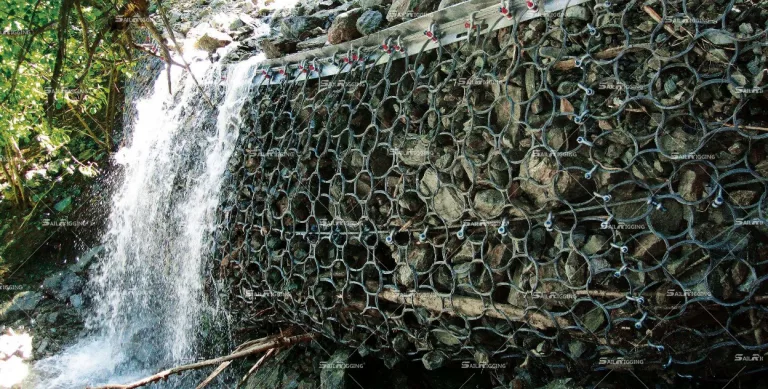Today we are discussing shackles in rockfall and debris flow protection systems, shackles are very critical component that connects and secures these systems. In this article, we will explore why shackles are so important in rockfall and debris flow protection, how their strength and reliability contribute the overall safety.
Why shackles are important in rockfall and debris flow protection?
Rockfall and debris flows are natural hazards that can pose significant risks to infrastructure, human lives, and the environment, particularly in mountainous or unstable terrain. To mitigate these risks, specialized protective systems are used, often involving the use of high-tensile nets, barriers, and cables.
Shackles are metal links, typically in the shape of a U or bow, with a pin or bolt across the opening. They serve as connecting devices that join various rigging components such as chains, cables, nets, and anchors in rockfall and debris flow protection systems. Here’s why they are indispensable in these applications:
- Load-Bearing Capability: The shackles in these protection systems are designed to bear immense loads. During a rockfall or debris flow, the netting and barriers must absorb and contain the energy generated by falling rocks or fast-moving debris. Shackles help to distribute these forces evenly across the system, preventing any single component from bearing excessive stress, which could lead to failure.
- Durability and Strength: Shackles used in rockfall protection are made from high-strength materials like carbon steel or alloy steel. These materials provide the toughness needed to withstand the dynamic loads caused by falling rocks and debris. The durability of shackles ensures long-term performance even in harsh outdoor environments, including exposure to rain, snow, and temperature variations.
- Flexibility and Versatility: Rockfall and debris flow protection systems are often installed in rugged, uneven terrain. Shackles offer the flexibility needed to connect various components, regardless of the angles or distances involved. Bow shackles, for instance, allow for multi-directional load-bearing, making them ideal for connecting nets to posts or tensioning cables in difficult terrain.
Types of Shackles Used in Rockfall and Debris Flow Systems
Several types of shackles are commonly used in these protective systems, each designed for specific functions:
Bow Shackles: With a larger rounded “bow” shape, bow shackles allow for greater side-to-side movement, making them suitable for connections that may involve multi-directional forces, such as securing the edges of protective nets.
D Shackles (Dee Shackles): These shackles have a more rigid, straight-sided design, which is ideal for connections where the load is expected to be in a single direction, such as attaching anchor cables to fixed points.
Screw Pin Shackles: These shackles use a threaded pin to secure the opening, making them easy to install and remove without specialized tools. Screw pin shackles are useful in applications where the system may need to be adjusted or reconfigured regularly.
Bolt-Type Shackles: For more permanent installations, bolt-type shackles with a bolt, nut, and cotter pin offer added security, preventing accidental dislodgement of the pin during high-stress events like rockfalls or debris flows.
How Shackles Enhance System Safety
The primary function of shackles in rockfall and debris flow protection systems is to ensure that all components stay securely connected under extreme stress. Here’s how they contribute to overall system safety:
Absorbing Dynamic Loads: During a rockfall event, the energy generated by falling rocks can be immense. Shackles, particularly those made from high-tensile materials, help absorb and redistribute this energy throughout the protection system, preventing localized overloads that could lead to structural failure.
Preventing System Breakdowns: Shackles serve as crucial connectors between nets, posts, cables, and anchors. A failure in any one of these connections could compromise the entire system. By using high-quality shackles with appropriate load ratings, system integrity is maintained even under extreme conditions.
Corrosion Resistance: Shackles in outdoor protection systems must withstand harsh environmental conditions. Galvanized or stainless-steel shackles are often used because they provide excellent resistance to corrosion, ensuring that the shackles remain functional and reliable over time.
Easy Inspection and Maintenance: One of the advantages of shackles is that they can be easily inspected for wear and tear. Unlike permanent welds, shackles allow for easy replacement of components without needing to dismantle the entire system. This makes ongoing maintenance more efficient, ensuring the protection system remains effective.
Selecting the Right Shackle for Rockfall and Debris Flow Protection
Choosing the right shackle for a rockfall or debris flow protection system requires careful consideration of several factors:
Load Rating: The shackle’s load rating must exceed the maximum expected forces during a rockfall or debris flow event. Underrated shackles can compromise the entire system.
Material: Depending on the environment, shackles should be made from materials that resist corrosion, such as galvanized steel or stainless steel. For highly corrosive environments, stainless steel is often preferred for its superior longevity.
Type of Shackle: Depending on the system’s layout, either bow shackles or D shackles may be more appropriate. Bow shackles offer more flexibility for multi-directional loads, while D shackles are better suited for straight-line connections.
Safety Standards: Ensure that the shackles comply with international safety standards such as ASME B30.26 or ISO standards, which guarantee the reliability and safety of the product.
In a conclusion, shackles play an indispensable role in rockfall and debris flow protection systems, ensuring that all components are securely connected and capable of withstanding extreme forces. By choosing the right type of shackle, made from high-strength materials and rated for the specific load conditions, you can significantly enhance the effectiveness and safety of the entire protection system. Whether in rugged mountain terrain or high-risk construction zones, shackles remain a vital component in safeguarding lives and property from natural hazards.
For more information on high-quality shackles for rockfall and debris flow protection systems, you could consult Sail Rigging right now.





